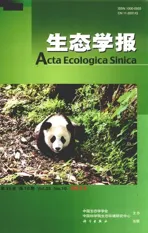绿色屋面降雨径流水质及消减污染负荷研究
2015-02-08张千千王效科万五星欧阳志云
张千千,王效科,高 勇,万五星,欧阳志云
1 中国地质科学院水文地质环境地质研究所, 石家庄 050061 2 中国科学院生态环境研究中心城市与区域生态国家重点实验室, 北京 100085 3 河南省环境监测中心, 郑州 450004; 4.河北师范大学生命科学院, 石家庄 050016
绿色屋面降雨径流水质及消减污染负荷研究
张千千1,2,王效科2,*,高 勇3,万五星2,4,欧阳志云2
1 中国地质科学院水文地质环境地质研究所, 石家庄 050061 2 中国科学院生态环境研究中心城市与区域生态国家重点实验室, 北京 100085 3 河南省环境监测中心, 郑州 450004; 4.河北师范大学生命科学院, 石家庄 050016

绿色屋面; 降雨径流; 径流水质; 污染负荷
随着城市化进程加快,不透水地表面积越来越高,不透水下垫面改变了原有的水文循环过程,增加了地表径流量,对受纳水体造成了严重影响[1],进而引起了城市管理者及相关研究人员对管理和控制暴雨径流的重视。研究者提出了大量的控制措施,如植被过滤带,人工湿地,渗透系统等。由于上述措施要求使用大面积的土地,在城市区域没有足够的空间实施,加之城市区域地价昂贵,严重影响了面源污染控制的广泛开展。城市建筑屋面在城市建设用地中比重较高(约占城市不透水下垫面总面积的40%—50%),在城市面源污染中发挥着重要的作用。因此,研究者提出将硬化屋面“绿化”的新控制理念。
“绿色”屋面也被称之为植被屋面和生态屋面,是城市区域中一类特殊的地表覆盖类型[2]。常见的绿色屋面种类有集约型屋面和粗放型屋面两种。集约型屋面可以被作为一个花园,它具有较厚的土壤层,可以种植比较大的植物,如乔木和灌木树种;而粗放型屋面是指土壤层较薄,只能种植草本或者更小的植物[3]。与不透水下垫面相比,绿色屋面具有生态化属性,很多城市暴雨管理理念将其作为城市面源污染的控制技术之一,如美国的BMPs(Best Management Practices)和英国SUDS(Sustainable Urban Drainage Systems)等[4]。

本研究的主要目的是基于径流水质和污染负荷2个方面,综合评价绿色屋面对径流水质的影响和污染负荷的增减;并且确定绿色屋面径流水质和降雨特征之间的关系。以期为正确评价绿色屋面对径流水质的影响提供数据支持,并为绿色屋面的科学构建和城市暴雨径流管理提供了重要参考。
1 材料与方法
1.1 研究区域概况
重庆地区地形地貌结构较为复杂。地貌类型可分为中山、低山、丘陵、台地、平原(坝)五大类。区域属四川盆地热带季风湿润气候,气候温和,雨量充沛,四季分明。年均降雨量为1085.3 mm,夏季占年降水量40%—50%,历年平均相对湿度为79%,日照时数1243.8 h。年平均气温17.5—18.7 ℃,无霜期296 d。
1.2 绿色屋面和控制(沥青)屋面设计
绿色屋面和沥青屋面建于2010年8月,位于重庆市北部新区竹林实验学校的实验楼顶部,并排放置。绿色屋面的面积为1 m2(1 m×1 m),沥青屋面的面积为2.25 m2(1.5 m×1.5 m)。在屋面的四周安装40 cm高的PVC板,防止雨水飞溅和流失。屋面的出水口接一个直径8 cm的PVC管,PVC管连接1 m长的塑料管,塑料管与雨水收集箱相连。
1.3 绿色屋面的结构
绿色屋面的结构主要包括6层(图1),从上向下依次为植物层、种植基质层(土壤层)、过滤层、排水层、防水层(沥青纸)和水泥板。

图1 实验屋面及绿色屋面结构
基质层 本层为混合基质层,采用筛选的轻质材料混合而成,减轻屋顶的承重力,各基质的体积比为:泥炭土∶蛭石∶珍珠岩∶锯末=4∶3∶2∶1,然后将各基质混匀,混合基质层厚度为15 cm。主要功能是承载植物层,为植物层提供生长必须的养分和水。
过滤层 过滤层选用材料为聚酯纤维无纺布,具有较好的过滤、排水、隔离,且材料重量轻、抗拉强度高、渗透性好等,既能透水又能隔绝种植土中的细小颗粒,主要功能是当水流经基质层时,利用针刺土工布良好的透气性和透水性使水流通过,有效截留土颗粒、细砂和小石料等,防止堵塞排水层。
排水层 排水层选用新型块状塑料蓄水板,规格为33.3 cm × 33.3 cm × 2.0 cm,主要作用是迅速排除在降雨和浇灌时多余的水分,有效缓解瞬时压力,改善基质的通气状况,存储部分水分,具备保温隔热、阻根刺(防止植物根系破坏混凝土结构)、质轻、耐高负荷等多种功能。该层铺设在过滤层下,平时注意及时清理枯枝落叶,防止排水口堵塞。
防水层 在原有水泥屋面的基础上再铺设改性沥青油毡作为附加防水层。
植物层 是屋顶绿化的主要功能层, 生态、经济、社会等效益都体现在这一层当中。植物选择佛甲草(SedumlineareThunb),又名万年草,为景天科佛甲草属多年生草本植物。种植株距为4—6 cm,行距为8—10 cm。
1.4 样品采集与分析
绿色屋面和沥青屋面均通过 U-PVC 管与采样容器相连(图1),使降雨产流全部收集在容器中。每场降雨之前,采样容器均用自来水和超纯水冲洗干净,并盖好盖子,降雨结束后收集雨水;干湿总沉降采样:上次降雨采集样品后,将采样箱用自来水和超纯水冲洗干净,放于屋面上,当下次降雨停止时,立即收集样品;湿沉降采样:在下雨前,将采样箱放于屋面上,雨停后,收集雨样。在采样点附近安装了JDZ- 1型数字雨量计,收集降雨的资料。研究期间对绿色屋面,沥青屋面,干湿总沉降和降雨同步采样12次。降雨事件的降雨特征见表1。
1.5 数据分析
由于本研究所得数据未满足正态分布,所以,运用非参数的Kruskall-Wallis和Mann-WhitneyU检验方法,分析了绿色屋面、沥青屋面、干湿总沉降和降雨中各污染物浓度和污染负荷的显著差异性。此外,运用Spearman′s秩相关系数分析了降雨特征对绿色屋面径流水质的影响。
2 研究结果
2.1 降雨特征描述
表1列出了所监测降雨事件的特征。由表1可知,所监测的12场降雨事件差异较大,其中暴雨2场,大雨4场,中雨3场,小雨3场。12场降雨事件包括了不同降雨强度的降雨,具有较好的代表性,为研究结果的可靠性提供了保证。
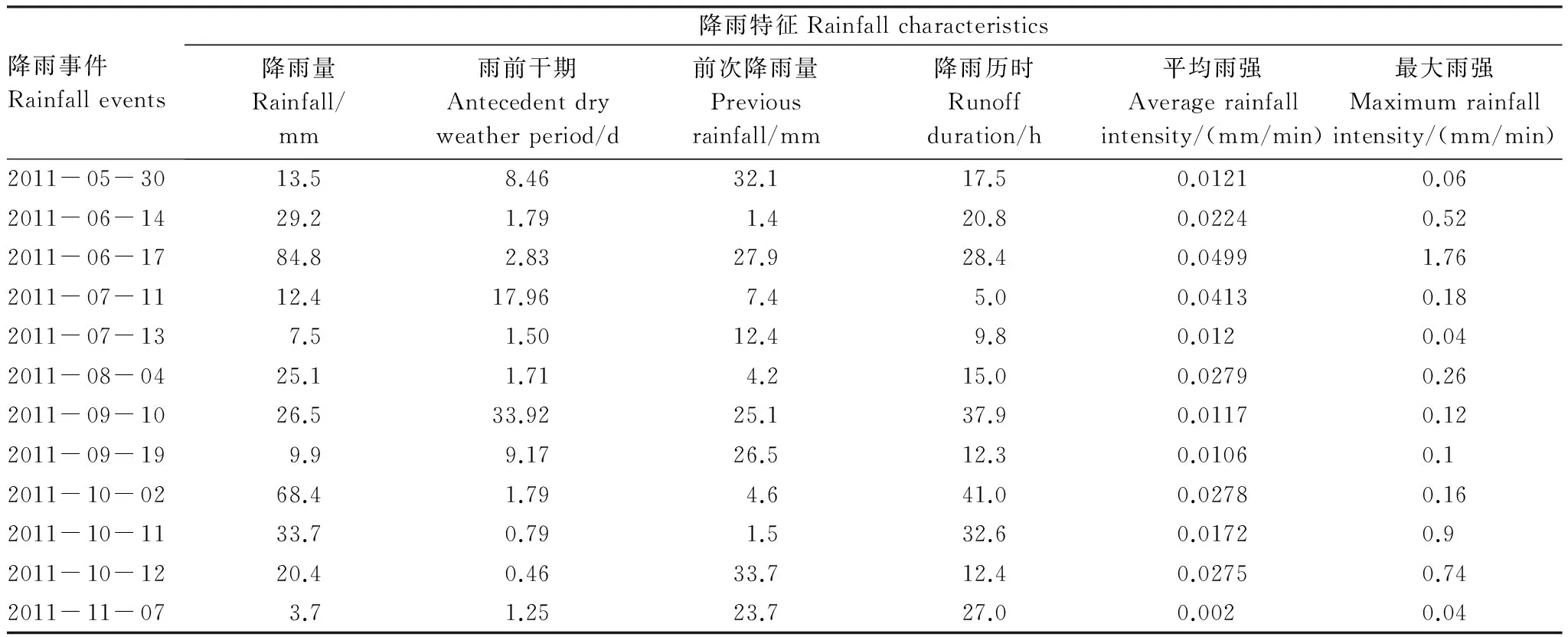
表1 监测降雨事件的特点Table 1 The characteristics of investigated rain events
2.2 绿色屋面和沥青屋面降雨径流与干湿沉降和降雨的水质特征比较
2.2.1 pH、EC和TSS
(1) pH值的平均浓度表现为:沥青屋面(7.35)要显著的高于绿色屋面(6.84),干湿沉降(5.98)和降雨(5.61)(图2)。雨水和干湿沉降pH值的浓度低于了国家地表水的标准(6.0—9.0)[15],但是,在绿色屋面上,pH值的浓度满足了国家地表水的标准,因此,绿色屋面对降雨径流中pH值有很好的中和作用;
(2) EC的平均浓度表现为:绿色屋面(224.85 μS/cm)要显著的高于沥青屋面(65.47 μS/cm),干湿沉降(48.63 μS/cm)和降雨(37.59 μS/cm) (图2)。绿色屋面是EC的源;
(3) TSS的平均浓度表现为:绿色屋面(20.42 mg/L)要显著的低于沥青屋面(67.04 mg/L),并且低于干湿沉降(36.53mg/L)(图2),绿色屋面是TSS的汇。
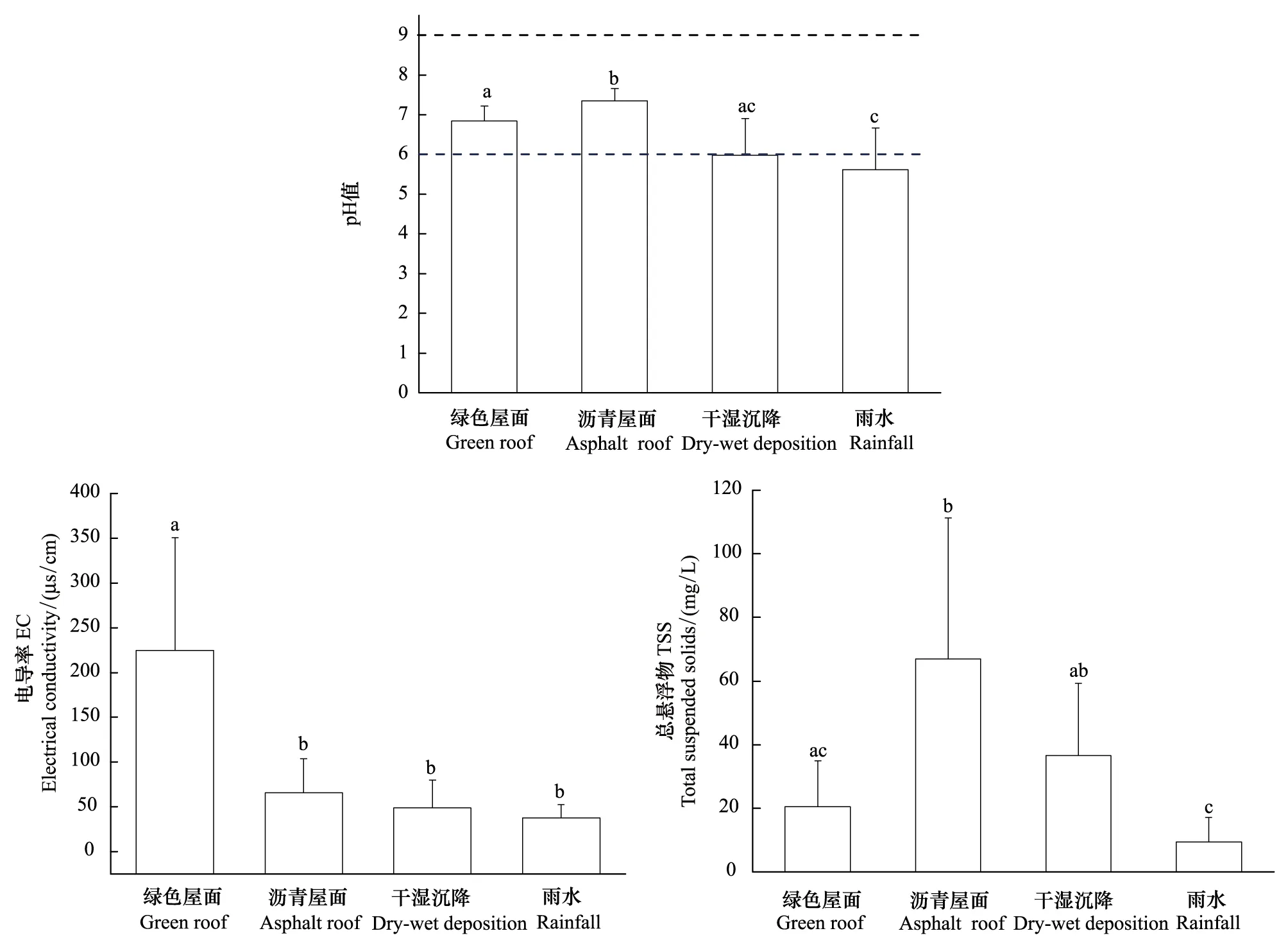
图2 绿色屋面、沥青屋面、干湿沉降和降雨采样中 pH, EC和 TSS的平均浓度

(1)TP的平均浓度表现为:雨水(0.035 mg/L)要显著低于绿色屋面(0.113 mg/L),沥青屋面(0.091 mg/L)和干湿沉降(0.076 mg/L)(图3),但是TP的浓度在绿色屋面,沥青屋面和干湿沉降采样中无显著差别,因此,绿色屋面对于TP是非源非汇。


图3 绿色屋面、沥青屋面、干湿沉降和降雨采样中TP和与的平均浓度
2.2.3 COD和BOD5
由图4所示, COD和BOD5的平均浓度表现为:绿色屋面 (230.63 mg/L 和11.05 mg/L)要显著高于沥青屋面(105.24 mg/L和4.88 mg/L),干湿沉降 (52.63 mg/L和 4.44 mg/L) 和降雨 (42.73 mg/L和2.55 mg/L)。在绿色屋面径流中有机污染物主要来源于土壤有机物和植物的腐烂,绿色屋面是COD和BOD5的源。

图4 绿色屋面、沥青屋面、干湿沉降和降雨采样中 BOD5 和COD的平均浓度
2.2.4 溶解态重金属(DPb、DCu和DZn)
由图5所示,DCu和DZn的平均浓度表现为:在绿色屋面 (13.02 μg/L和52.27 μg/L),沥青屋面(4.80 μg/L和8.88 μg/L),干湿沉降 (18.58 μg/L和28.11 μg/L)以及降雨(4.93 μg/L和28.63 μg/L)无显著差异,这或许是由于屋面径流中的DCu和DZn主要来源于干湿沉降。DPb、的平均浓度表现为:绿色屋面 (17.26 μg/L)要显著高于沥青屋面(5.15 μg/L),干湿沉降(5.42 μg/L) 和降雨(6.58 μg/L)。绿色屋面是DPb的源。
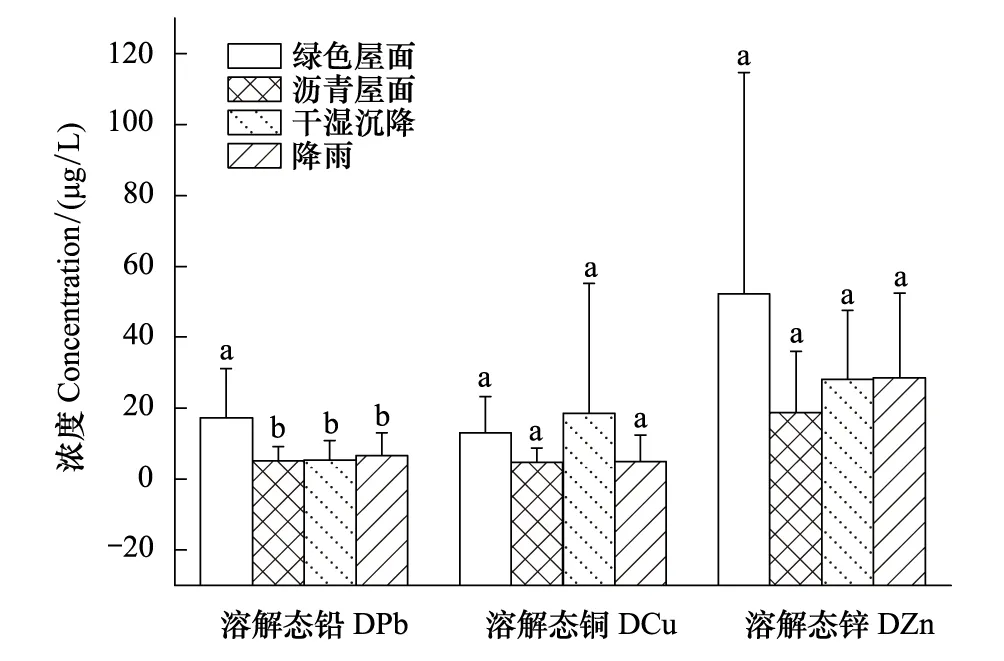
图5 绿色屋面、沥青屋面、干湿沉降和降雨采样中DPb、DCu和DZn的平均浓度
2.3 绿色屋面,沥青屋面,干湿沉降和降雨的污染负荷比较

2.4 降雨特征对绿色屋面径流水质的影响
该研究通过分析各场次降雨事件中各污染物的浓度与降雨特征的相关关系(表3),结果表明:pH值与降雨量在0.05显著水平下呈负相关关系;TP和TSS与降雨间隔在0.05显著水平下呈正相关关系,BOD5与降雨间隔在0.01显著水平下呈正相关关系;DCu和DZn与最大雨强在0.05水平下呈负相关。各水质参数与降雨历时和平均雨强均无显著相关关系。
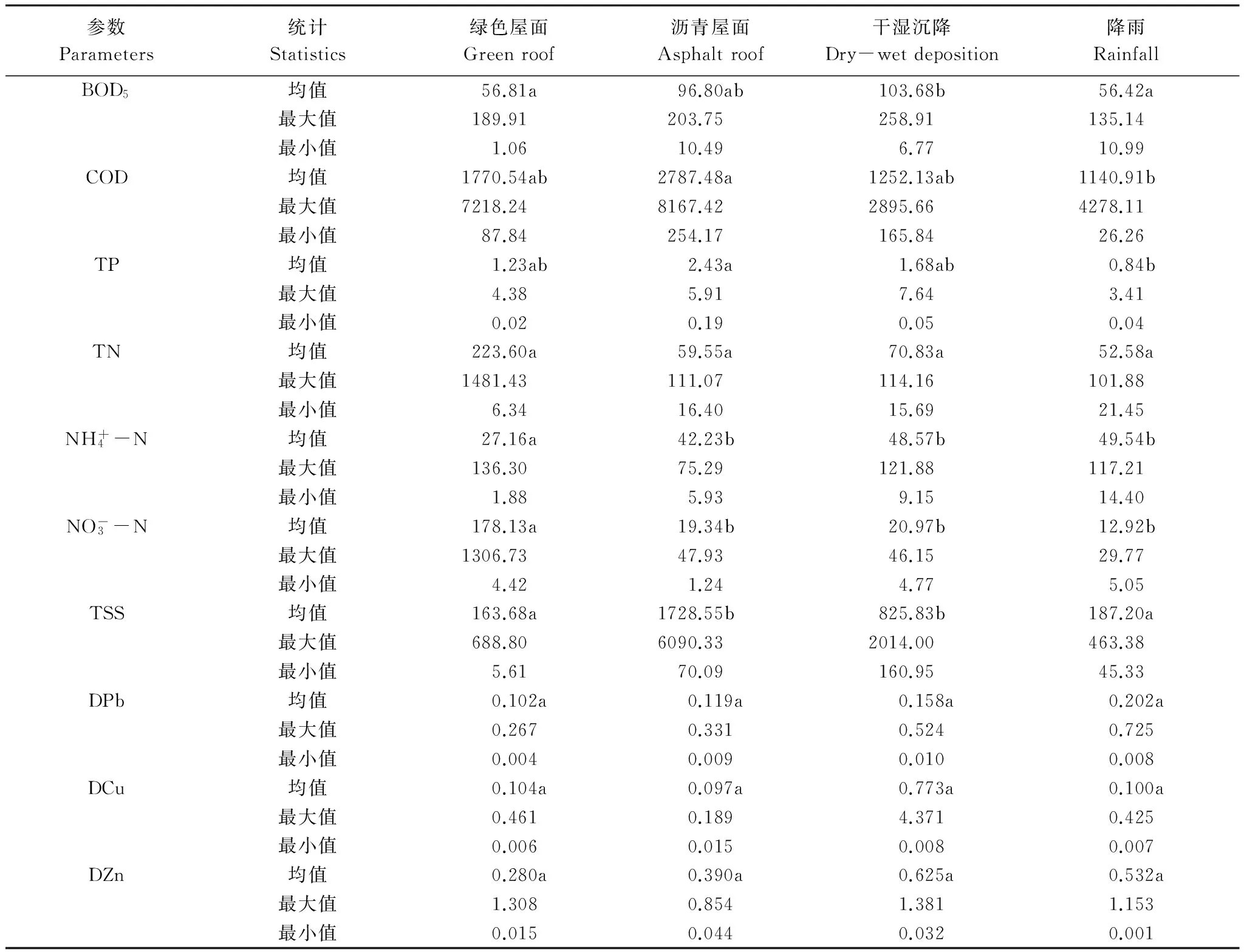
表2 绿色屋面、沥青屋面、干湿沉降和降雨采样中各水质参数的污染负荷比较/(mg/m2)Table 2 Comparison of the pollution load of water quality parameters for green roof, asphalt roof, rainwater and dry-wet deposition

表3 径流水质与降雨特征的相关关系分析Table 3 Correlation analysis between runoff quality and characteristics of the rainfall
3 讨论
3.1 绿色屋面的源汇特征探讨

3.2 影响绿色屋面径流水质的因素


表4 绿色屋面和沥青屋面径流水质污染负荷分析Table 4 Analysis for pollutants load of green roof (GR) and asphalt roof (AR)


降雨强度决定着淋洗、冲刷地表污染物的能量大小。降雨强度对屋面径流中污染物的种类和数量有显著的影响,这主要由于某些污染物主要以微粒态形式存在,这些污染物只有在高的降雨强度下才能被冲刷。本研究结果表明:各污染物的平均浓度与平均雨强和最大雨强均呈负相关关系。这与欧阳威等人[21]和张千千等人[22]研究结果相同。
4 结论


(4)统计分析表明:多数污染物与降雨量、降雨历时和降雨强度呈负相关关系,与降雨间隔呈正相关关系。
[1] US EPA. National Water Quality Inventory: 1996 Report to Congress. Washington DC: EPA Office of Water. Report no. EPA 1998, 841-F- 97-003.
[2] Berndtsson J C, Bengtsson L, Jinno K. Runoff water quality from intensive and extensive vegetated roofs. Ecological Engineering, 2009, 35(3): 369- 380.
[3] FLL. Guideline for the Planning, Execution and Upkeep of Green-roof Sites. Bonn, Germany: Forschungsgesellschaft Landschaftsentwicklung Landschaftsbau e.V., 2002.
[4] 王书敏, 于慧, 张彬, 邵磊. 绿色屋顶技术控制城市面源污染应用研究进展. 重庆文理学院学报: 自然科学版. 2011, 30(4):59- 64.
[5] Mentens J, Raes D, Hermy M. Green roofs as a tool for solving the rainwater runoff problem in the urbanized 21st century? Landscape and Urban Planning, 2006, 77(3): 217- 226.
[6] Vijayaraghavan K, Joshi U M, Balasubramanian R. A field study to evaluate runoff quality from green roofs. Water Research, 2012, 46(4): 1337- 1345.
[7] Berndtsson J C, Bengtsson L, Jinno K. First flush effect from vegetated roofs during simulated rain events. Hydrology Research, 2008, 39(3): 171- 179.
[8] Wong N H, Chen Y, Ong C L, Sia A. Investigation of thermal benefits of rooftop garden in the tropical environment. Building and Environment, 2003, 38(2): 261- 270.
[9] Fang C F. Evaluating the thermal reduction effect of plant layers on rooftops. Energy and Buildings, 2008, 40(6): 1048- 1052.
[10] Currie B A, Bass B. Estimates of air pollution mitigation with green plants and green roofs using the UFORE model. Urban Ecosystems, 2008, 11(4): 409- 422.
[11] Gedge D, Kadas G. Green roofs and biodiversity. Biologist, 2005, 52(3): 161- 169.
[12] Dunnett N, Nagase A, Hallam A. The dynamics of planted and colonising species on a green roof over six growing seasons 2001- 2006: influence of substrate depth. Urban Ecosystems, 2008, 11(4): 373- 384.
[13] Berndtsson J C, Emilsson T, Bengtsson L. The influence of extensive vegetated roofs on runoff water quality. Science of the total Environment, 2006, 355(1/3): 48- 63.
[14] 国家环境保护总局. 水和废水监测分析方法 (第四版). 北京: 中国环境科学出版社, 2002.
[15] 国家环境保护总局. 地表水环境质量标准 (GB 3838- 2002). 北京: 中国环境科学出版社, 2002.
[16] Moran A C, Hunt B, Jennings G. A North Carolina Field Study to Evaluate Greenroof Runoff Quantity, Runoff Quality, and Plant Growth [D]. Raleigh: North Carolina State University, 2004.
[17] Moran A, Hunt B, Smith J. Hydrologic and water quality performance from greenroofs in Goldsboro and Raleigh. North Carolina. 2005: 4- 6.
[18] Teemusk A, Mander Ü. Rainwater runoff quantity and quality performance from a greenroof: The effects of short-term events. Ecological Engineering, 2007, 30(3): 271- 277.
[19] Bliss D J, Neufeld R D, Ries R J. Storm water runoff mitigation using a green roof. Environmental Engineering Science, 2009, 26(2): 407- 418.
[20] Farreny R, Morales-Pinzón T, Guisasola A, Tayà C, Rieradevall J, Gabarrell X. Roof selection for rainwater harvesting: Quantity and quality assessments in Spain. Water Research, 2011, 45(10): 3245- 3254.
[21] 欧阳威, 王玮, 郝芳华, 王云慧. 北京城区不同下垫面降雨径流产污特征分析. 中国环境科学, 2010, 30(9): 1249- 1256.
[22] 张千千, 王效科, 郝丽岭, 侯培强, 逯非, 欧阳志云. 重庆市不同材质屋面径流水质特性研究. 环境科学研究, 2012, 25(5): 579- 586.
[23] 李立青, 尹澄清, 孔玲莉, 何庆慈. 2次降雨间隔时间对城市地表径流污染负荷的影响.环境科学, 2007, 28(10): 2287- 2293.
[24] Vaze J, Chiew F H S. Experimental study of pollutant accumulation on an urban road surface. Urban Water, 2002, 4(4): 379- 389.
Research on green roof in water quality of rainfall runoff and reduction of pollution load
ZHANG Qianqian1,2, WANG Xiaoke2,*, GAO Yong3, WAN Wuxing2,4, OUYANG Zhiyun2
1InstituteofHydrogeologyandEnvironmentalGeology,ChineseAcademyofGeologicalScience,Shijiazhuang050061,China2StateKeyLaboratoryofUrbanandRegionalEcology,ResearchCenterforEco-EnvironmentalSciences,ChineseAcademyofSciences,Beijing100085,China3HenanProvinceEnvironmentalMonitoringCenter,Zhengzhou450004,China4CollegeofLifeScience,HebeiNormalUniversity,Shijiazhuang050016,China
With the rapid urbanization and continued improve to control urban point source pollution in China, the ratio of urban surface runoff accounted for pollution load of receiving water will be raised increasingly and pose a serious threat to urban water body. “Green” roofs, also referred to as vegetated or ecology roofs, are of the important technologies for controlling urban nonpoint source pollution, which has been taken as an important component of technical system in many advanced concepts for the management of urban stormwater runoff. Green roof has several beneficial effects in an urban setting, such as their ability to retain and detain roof stormwater runoff, reduce urban heat islands, improve air quality, provide wildlife habitats, and their esthetic value. However, there is a very important aspect that has often been overlooked in previous studies is the quality of the runoff water from green roofs. Therefore, it is very important to investigate runoff water quality from green roofs for its popularization and application. In the paper, we investigated water quality of storm runoff from green roof, asphalt roof (control roof), dry-wet deposition and rainfall from May to December, 2011, and calculated the pollution load of them, and analyzed the effect of rainfall characteristics on runoff water quality using multivariate statistical analysis. Compared the water quality from green roof, asphalt roof (control roof), dry-wet deposition and rainfall, we found that the green roof was a sink of total suspended solids (TSS), because the average TSS concentration of the green roof (20.42 mg/L) was significantly lower than on the asphalt roof (67.04 mg/L) and was also lower than that of the dry-wet deposition (36.53 mg/L) samples. The green roof can neutralize the pH from 5.61 to 6.84. The green roof is non-source and non-sink for total phosphorus (TP), dissolved copper (DCu) and dissolved zinc (DZn); conversely, the green roof was a source of electrical conductivity (EC), total nitrogen (TN), ammonium nitrogen (NH+4-N), nitrate nitrogen (NO-3-N), chemical oxygen demand (COD), biochemical oxygen demand after 5 days (BOD5) and dissolved lead (DPb), because the average concentration of there parameters of green roof was significantly higher than of the asphalt roof, dry-wet deposition and rainfall. However, considered about the pollution load from green roof, asphalt roof (control roof) and dry-wet deposition, we noticed that the green roof was a sink of NH+4-N, TSS and BOD5, the green roof is non-source and non-sink for TN, DPb, DCu, DZn, TP and COD, conversely, the green roof was a source of NO-3-N. Compared the pollution load between green roof and asphalt roof (control roof), 90.53% of TSS, 49.38% of TP, 41.31% of BOD5, 36.48% of COD, 35.45% of NH+4-N, 28.27% of DZn and 14.20% of DPb could be abated, however, 821.02% of NO-3-N and 275.48% TN could be added; The concentration of the pollutants of green roof runoff were negatively correlated with precipitation, rainfall duration and rainfall intensity, however, there was positive correlation with the antecedent dry weather period. The results can provide a basis for design of the green roof and scientific assessment the effect of the green roof to runoff water quality.
green roof; rainfall runoff; runoff water quality; pollution load
国家水体污染控制与治理科技重大专项(2012ZX07307); 国家自然科学基金重点项目(41030744)
2013- 06- 24;
2014- 05- 30
10.5846/stxb201306241762
*通讯作者Corresponding author.E-mail: wangxk@rcees.ac.cn
张千千,王效科,高勇,万五星,欧阳志云.绿色屋面降雨径流水质及消减污染负荷研究.生态学报,2015,35(10):3454- 3463.
Zhang Q Q, Wang X K, Gao Y, Wan W X, Ouyang Z Y.Research on green roof in water quality of rainfall runoff and reduction of pollution load.Acta Ecologica Sinica,2015,35(10):3454- 3463.
